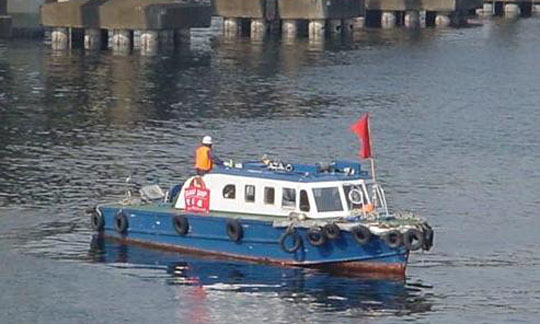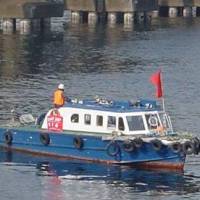Dear Alice,
When I'm in Tokyo on business, I like to take my morning run along the rivers and canals in the eastern part of the city. On several occasions now I've noticed smallish boats parked smack dab in the middle of a river, where you'd think they'd be in the way. That seems curious in and of itself, but in each case the boat in question also had a tie-on banner with the English words "guard ship." To be honest, the boats were kind of ratty and didn't look official. So what the heck were those boats guarding, and who the heck put them there?
Henry B., San Diego, Calif.
Dear Henry,
You weren't able to send me a photograph, so it took some lurking to launch this month's column. I had to spend a few hours wandering the waterfront, snug in my trench coat, until I spotted a boat with the banner you described. I could clearly see the words "guard ship," but the Japanese was harder to make out. With the help of binoculars (OK, and a dictionary) I discovered it read keikaisen, in characters that mean "warning boat." This gave me something to work with, but there was nothing to indicate who was doing the warning, or who was supposed to watch out for what.
Since the boat was stopped in Minato Ward, I set a course for the ward office. An official there looked over my surveillance photos and pointed out what I'd missed — the boat was near a bridge, and there was construction in progress on the pilings under the bridge.
Henry, you've probably already noticed that construction sites in Japan usually have a uniformed worker out front who bows to passersby to apologize for the inconvenience and usher them safely around danger. These guides are called "gaadoman," ostensibly from the English words "guard" and "man," although the term is recognized as wasei eigo (made-in-Japan English). Well, the short answer to your question is that what a gaadoman does on land, the bannered boats do on water. Keikaisen are posted near marine construction sites to alert oncoming traffic so they can steer clear of the work.
My next port of call was the Tokyo Metropolitan Government's Bureau of Port and Harbor because it turns out they have jurisdiction over all the waterways in Tokyo, even the little canal that runs behind The Japan Times head office in Shibaura. But no sooner had I tied up than I had to shove off again, this time for Yokohama. I had just learned that it's the Japan Coast Guard that watches over the use of keikaisen, as part of their mandate to ensure marine traffic safety. There are 11 Coast Guard regions in Japan, and the 3rd Region, headquartered in Yokohama, has jurisdiction over the busy port of Tokyo.
"It's difficult to say when keikaisen were first used in Japan, but their use has definitely increased along with the growing awareness of the need for safety measures," said Noboru Umehara, an official with the safety traffic division of the 3rd Regional Coast Guard Headquarters in Yokohama. "There was a boom in marine construction during the 1980s, so the Japan Coast Guard developed standardized guidelines for the placement of keikaisen."
He explained that anyone who plans to do any kind of marine construction, including dredging, bridge-building or repair, or maintenance of retaining walls, is required by law to submit an application to the Coast Guard that details what measures the company or organization will take to ensure the safety of other traffic on the water. The Coast Guard reviews the application, noting factors such as visibility, the volume of traffic and the width of passage around the construction site, and may recommend changes, including the placement of keikaisen.
For a simple project, such as repair of a retaining wall in a low-traffic area with good visibility, it may be enough to post a worker with a red flag on the wall to warn oncoming boats. For more complex construction, the coast guard may recommend two or more keikaisen in the water. A current example is the marine construction now in progress in Tokyo Bay near Haneda Airport, where a total of eight keikaisen are posted.
It's up to the construction supervisor to charter and pay for the boats that serve as keikaisen, and it's common for fishing and other commercial boats to engage in this work part time. Boats serving as warning boats must have some sign that identifies them as on the job, which is where the "guard ship" banner comes in, and they are required to have at least two people on board — the captain and someone on deck with a red flag. Keikaisen are also required to carry equipment such as binoculars, signal flags and a bull horn, and when posted in busy channels frequented by foreign ships, a short-wave radio. Keikaisen do not have legal authority to stop other boats, and are there only to provide safety information to other traffic as well as workers engaged in the construction.
What I couldn't find out, and no one I spoke to in Japan knew, was whether there's a similar system in other countries. I'm hoping our readers can help out. Does anyone know if warning boats are commonly posted near marine construction sites in other countries? Is this an internationally accepted safety measure or something done only in Japan? Drop me a line at the address below and I'll share the information in a future column.
I'd also like to spread awareness of Japan's marine emergency services number, which is "118" (said aloud as "ichi ichi hachi ban"). Punch in these three digits from any phone, including a mobile phone, and you'll be immediately connected to an operator trained in emergencies at sea. You should call this number if you witness or are involved in a marine accident, or if you spot a vessel that seems in trouble or acting suspiciously.


















With your current subscription plan you can comment on stories. However, before writing your first comment, please create a display name in the Profile section of your subscriber account page.